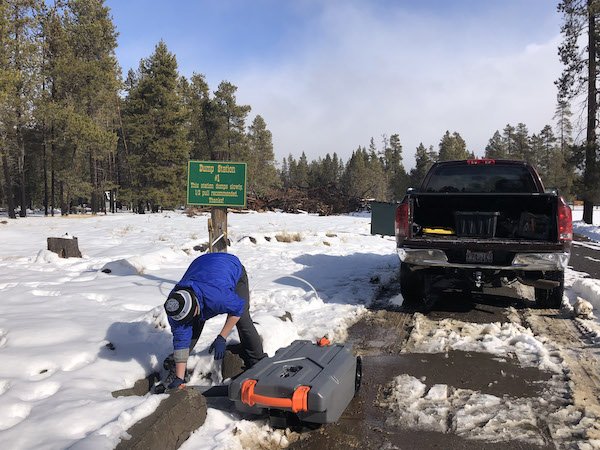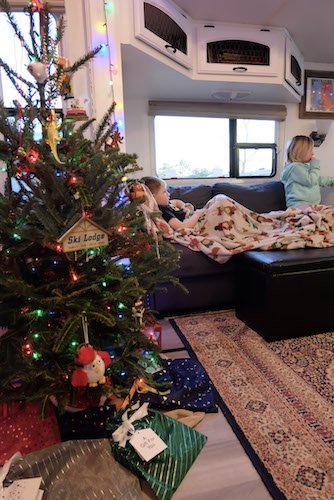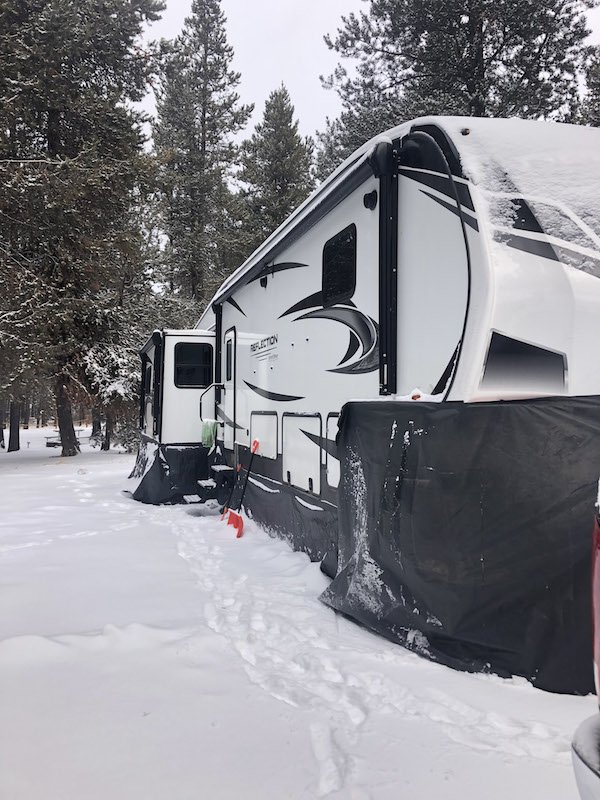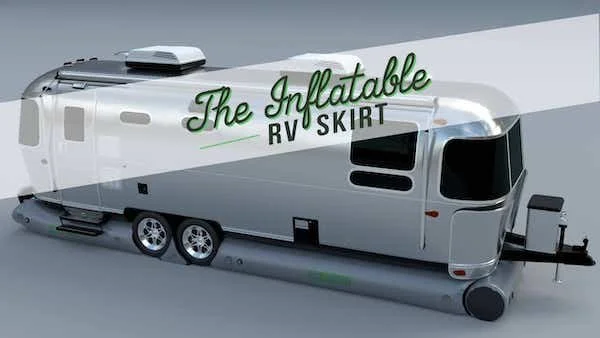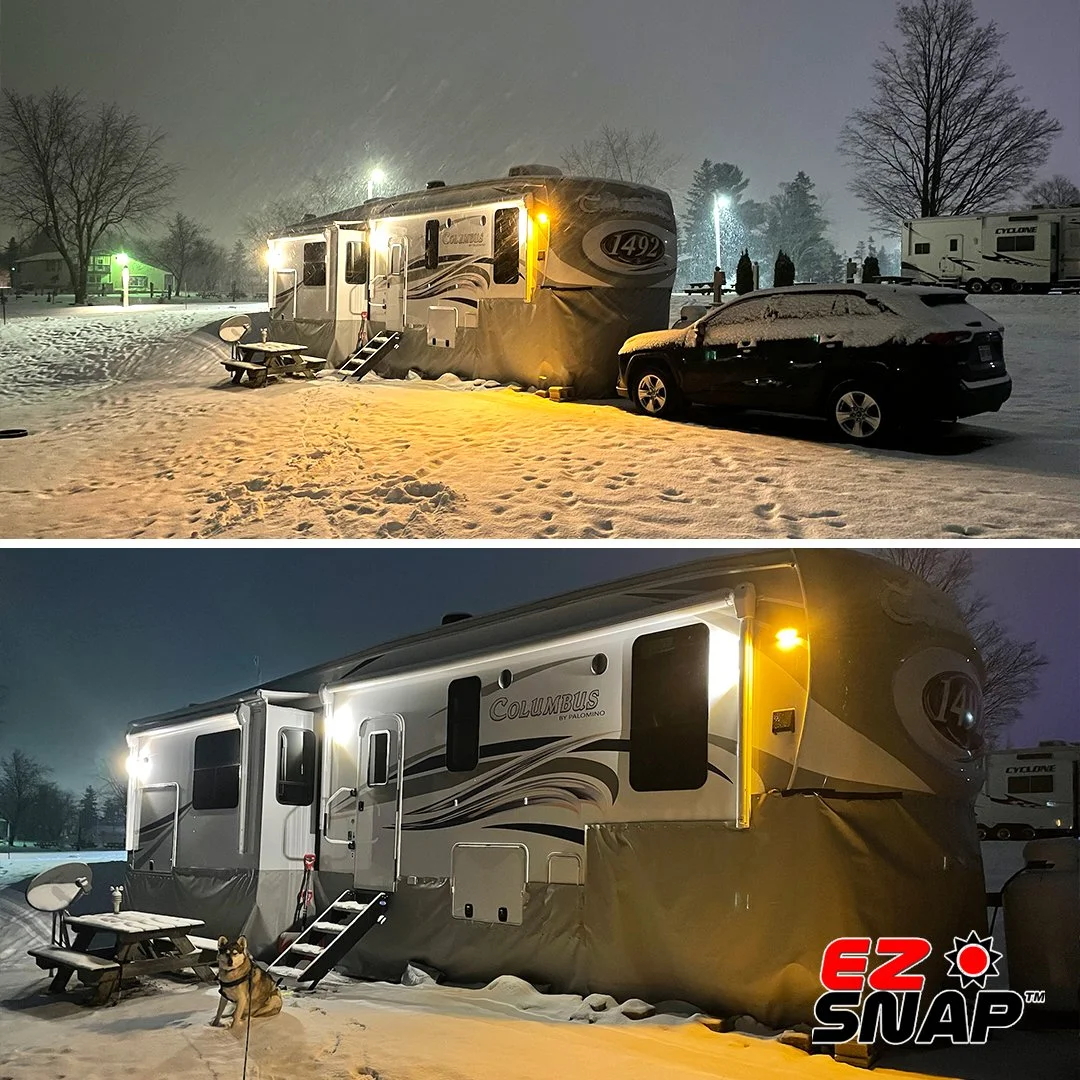RV in Winter: How to Live in the Cold & Stay Warm
RVing during the cold winter months isn’t impossible. Maybe you need to live full-time in your RV during the winter because of work. Maybe you want to travel to certain areas when it’s not peak tourist season. Maybe you’re like us and love skiing and exploring new resorts so you chase the snow instead of the sun. Whatever the reason, you can RV in winter! In order to protect your home on wheels and stay warm while inside there are simple ways to get your rig ready. Here are our first-hand tips on how to RV in winter!
Keep Water Flowing
Before we did our homework and knew any better, on more than one occasion we woke to no water while winter camping. Water froze in our pipes. Luckily, no damage was done but that won’t always be the case. Making sure your water doesn’t freeze isn’t only important for you, but it’s also important for your rig!
Invest in a Reliable Heated Hose: When connecting to city water, a heated hose is a must-have accessory. A specialized hose prevents water from freezing while flowing into your RV. It comes with insulated sleeves for added protection and is suitable for temperatures as low as -20℉.
Consider Extra Insulation: If you anticipate extended freezing periods, consider adding additional insulation to your heated hose. Wrapping the hose with foil or foam insulation tape can provide extra safeguarding against the cold.
Opt for Freshwater Tank Fill: If you don't have a heated hose, filling your freshwater tank instead of using city water hookups is a practical solution. Many modern RVs have heated holding tank compartments to prevent freezing. For older RVs, insulation or a drop light inside the compartment can help maintain water temperatures.
Disconnect Water Hoses: After filling your freshwater tank, disconnect the water hose and drain all the water from it before storing it. This will extend the hose's lifespan and reduce the risk of freezing.
Maintain Interior Heat: To prevent your RV's pipes from freezing, ensure adequate heating throughout the interior. Open cabinets, allowing the heat from your furnace to reach all areas of the RV. You can also leave faucets slightly open to allow for a drip overnight, but be cautious not to overfill the grey water holding tank.
Consider Tank Blankets: For RVs without heated holding tank compartments, consider using tank blankets. These come in 12V DC and 120V AC models, suitable for both off-grid and on-grid winter RV camping.
Protect Exposed Water Lines: Many towable RVs have exposed water lines underneath, making them susceptible to freezing. To minimize the risk, add foam pipe insulation and wrap it with foam insulation or heat tape.
Holding Tanks
What comes in, must go out. That’s where your holding tanks come into play. These essential tanks hold your fresh water, gray water, and black water, and if they freeze, it can lead to serious issues. Here's how to protect your holding tanks from the icy grip of winter:
Insulate Tanks: Start by insulating your holding tanks with specialized tank blankets or foam insulation. These products help retain the heat generated by your RV's heating system, preventing the contents from freezing.
Heated Holding Tank Pads: Invest in heated holding tank pads designed to wrap around the tanks directly. These pads use electricity to keep the tanks warm, ensuring the liquids inside remain in a liquid state even in freezing temperatures.
Keep Tanks at Least Two-Thirds Full: It may seem counterintuitive, but keeping your holding tanks at least two-thirds full actually helps prevent freezing. The larger volume of liquid generates more heat, providing additional protection against freezing.
Use Tank Heaters and Heat Lamps: If you're camping in extreme cold conditions, consider using tank heaters or heat lamps placed near the holding tanks. These supplemental heat sources add an extra layer of protection against freezing. We actually just put a portable heater under the rig and it worked great!
Dump Tanks Strategically: Be mindful of when and where you dump your tanks. Avoid dumping them too early in the day when temperatures are lowest, and consider using designated dump stations that provide heated facilities for a smoother dumping process.
Monitor Tank Levels: Keep a close eye on the tank levels, especially if you're staying in extremely cold weather. Monitoring them regularly allows you to take immediate action if any issues arise.
Staying Warm Inside
When it comes to winter RVing, keeping the interior cozy and comfortable is key to enjoying your cold-weather adventures to the fullest. Insulating the interior not only helps retain warmth but also prevents cold drafts from seeping in. Here's how to insulate your RV's interior for maximum warmth:
Insulate RV Floor: As the chilly air tends to settle near the floor, it's essential to keep your feet warm. Add a touch of warmth by using interior rugs, carpet tiles, or floor mats to insulate your RV's floor. These simple additions not only provide comfort but also act as a barrier against the cold.
Insulate RV Windows and Doors: Windows and doors are prime spots for heat loss, but don't worry, we've got solutions for you! If you have a RV with single-pane windows, consider adding foil insulation to reduce heat loss. We used shrink film and it works great too. Plus you can still see through the windows which is a big win. Another option is upgrading to thicker window shades, which not only add insulation but also enhance the visual appeal of your interior. Don't forget door window covers and a reflective sunshade for your RV's front window to keep the warmth in.
Insulate RV Roof Vents: Since you won't need roof vents for air circulation during winter, installing vent cushions can significantly reduce heat loss. These nifty accessories not only keep your interior warm but can also be used during warmer months to trap cool air from your AC, making them an energy-saving investment. Plus, they're a breeze to install and remove.
While you're enhancing your RV's insulation, don't forget to check the weather stripping around your doors. Replacing any worn or missing weather stripping will keep the cold and moisture at bay, ensuring a snug and dry interior.
Note: When keeping your rig warm on the inside while temperatures are cool outside, you are prone to experience condensation. We found a heavy-duty dehumidifier kept this issue at bay!
Heat Sources
When embarking on winter RV camping adventures, staying warm becomes a top priority. Two primary heat sources come into play: the RV's built-in propane furnace and portable electric space heaters. Let's explore the benefits and considerations of each:
Propane Furnace: The RV's built-in propane furnace is an efficient way to heat the entire interior and underbelly of your RV. Before your winter trip, ensure the furnace is in good working order and clean all vents to maximize its effectiveness. Avoid installing a filter on the furnace if it wasn't factory-equipped with one. Winter camping tends to consume propane faster than usual, so ensure your onboard propane container(s) are adequately filled. If you are stationary consider renting a larger, external tank. We did this while camping in Park City, UT for a few months and found it much more convenient than constantly refilling smaller tanks!
Electric Space Heaters: Portable electric space heaters can be used to supplement the RV furnace if your RV is plugged into AC power during winter camping. They can help conserve propane and lower your energy bill, depending on the electric costs in your location. Be cautious not to overwhelm your RV's electrical system by using multiple high-draw appliances simultaneously. Avoid space heater models with a maximum wattage rating over 1,500 watts. Electric space heaters primarily heat the living space above the floor, so be mindful that they won't provide heat to the RV's underbelly. Though we did place one under our rig, and with the help of our RV skirt, it kept things extra warm!
Staying Warm (and Safe) Outside
Taking proper measures to protect your RV's exterior is also essential. From safeguarding your stabilizing jacks to ensuring your roof, AC, slide-outs, and awnings stay in top shape, here are some important steps to consider:
Insulate the RV Underbelly: To prevent RV stabilizing jacks from freezing to the ground, place wooden blocks, leveling blocks, or stabilizing jack pads beneath them. If you store recreation items under your RV, use a tarp or sealed bins to protect them from water damage. Installing an RV skirt can add an extra layer of insulation for the open space beneath your RV. This helps keep floors, holding tanks, and vehicle components warmer when temperatures drop below freezing. A skirt also provides protected exterior storage space, ideal for kayaks, bikes, or other items you want to shield from the elements.
Make Exterior RV Steps Safer: Prevent slipping on RV steps during freezing temperatures by installing wraparound step rugs for added grip. Consider adding an external handrail to enhance safety when entering and exiting your RV in winter. Not going to lie, I learned about stair safety the hard way and ended up in the ER!
Inspect RV Window Seals: Regularly check the condition of your RV's exterior window seals. If needed, add caulk or sealant before winter camping to maintain a watertight seal. Look for non-sagging or quick-drying products for easy application and minimal mess.
Protect Roof, AC, Slide-Outs, and Awnings: Remove snow and ice accumulation from all areas of your RV after each winter storm to prevent damage. This includes clearing snow from slide-outs, using slide-out supports to protect them from excess weight. In heavy snow events, consider closing slide-outs until the storm passes to minimize potential damage. Use a broom with soft bristles to clear a light dusting of snow from your roof. For larger accumulations, gently remove the top layer with a plastic shovel before pushing the bottom layer off with a broom. Leave your main RV awning closed during winter camping to avoid damage from snow, ice, and high winds. Consider installing an insulated cover over your A/C unit since it won't be in use during winter. This protects the unit from potential damage and keeps cold drafts at bay.
Don’t let cooler temps scare you away from living the RV life. With some preparation and the right supplies, wintertime RV living isn’t only possible, it’s enjoyable! I love cozying up in my tiny home on wheels while the snow falls. Hope to see you down the road!
This page contains affiliate links. That means we earn a small commission if you make a purchase through a link on this page. Thank you for your support!


